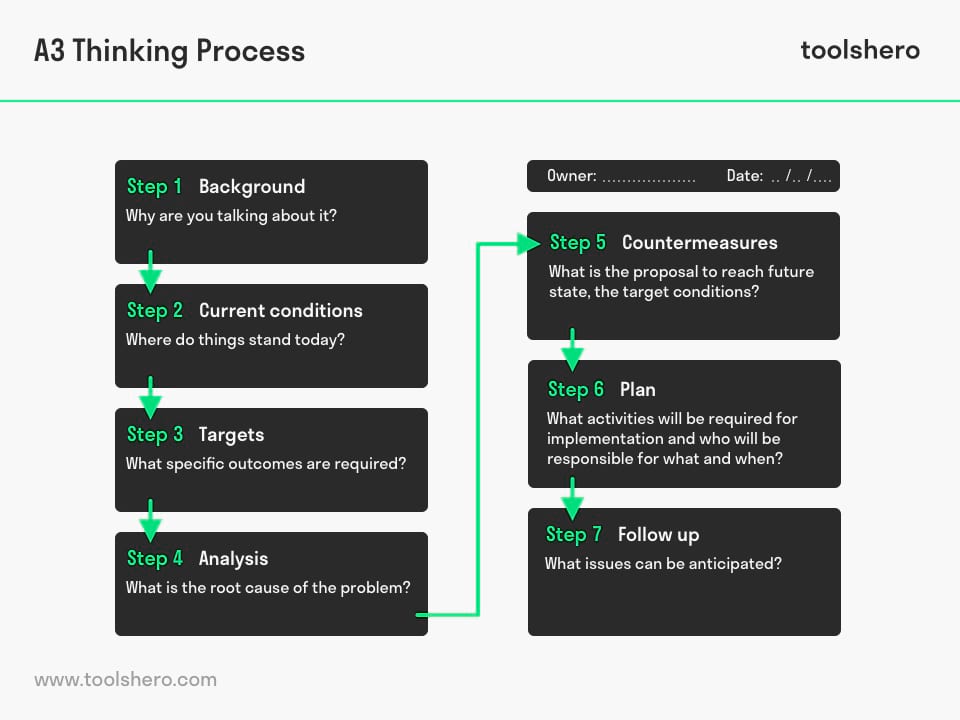A3 Lean: Template, Process and Examples

A3 Lean: this article explains the use of the A3 Lean template in a practical way. It covers its advantage and the process in steps, along with examples. It also contains a downloadable and editable A3 format lean single page template. After reading this article you will understand the basics of this powerful problem solving tool.
What is the A3 Lean template?
Most organizations are perfectly capable of solving problems. However, realizing a structured problem solving approach is often much more difficult.
Car giant Toyota has included the ability to continuously carry out improvements in operational performance in a structured process. This is called the A3 Lean Thinking Process.
Toyota describes problem identifications in a 10 step plan in which cooperation and personal development of employees is promoted. Both the results of the problem identification and the planning are represented in a concise A3 report. The name of the A3 Thinking Process is derived from this paper format.
Advantage of the A3 Lean template
Problems within an organization are often addressed superficially. The deeper, underlying causes of the problem are not always considered, allowing repetition to lie in wait. The same problems will resurface with the result that operational performance does not improve. The A3 Thinking process helps to arrive at a joint and detailed problem resolution. Underlying causes are thus eliminated.

Figure 1 – A3 Lean Thinking Process
A3 Lean template: steps and example
The A3 Lean template can be applied in almost any problem situation provided the ten steps are followed in the process:
Step 0. Identify a problem or need
The problem is recognized, acknowledged and identified by the team members of the A3 Lean template. This is also known as a problem statement.
Example: Structural late deliveries to customers.
Step 1. Understand current position
The problem can only be addressed by understanding the current situation. Toyota indicates that it is important to determine the extent of the problem.
Example: What percentage of the deliveries are late?
Step 2. Target
By drawing up countermeasures a new target will be formulated. The A3 Thinking team will specifically describe the expected improvements.
Example: Because of the new form of communication, the status of the delivery will be clear to the customer and the company.
Step 3. Root Cause Analysis
By finding out the causes of the problems, measures can be taken. The main causes are identified by the so-called ‘why’ questions via a Root Cause Analysis.
Example: Why are deliveries late? Why this percentage? Why are customers not informed?
Another good LEAN Manufacturing tool to analyse data is the Pareto Analysis
Step 4. Countermeasures
The underlying causes can be properly addressed by using countermeasures. As a result of this, structural changes are made in the work processes and the work will become more efficient once more. The A3 Thinking process team can work purposefully by pointing out the contents and the details of the countermeasures.
Example: the analysis in Step 2 has appointed ‘Poor communication to customers’ as the main cause.
A countermeasure could be that Stock Control maintains contacts with both the suppliers and the customers on a daily basis.
Step 5. Implementation plan
To achieve the goal, a carefully thought-out and workable implementation or action plan will be drawn up. This execution plan consists of an action list, responsible participants and has a time limit. Expenses and resources can also be included.
Example: The number of complaints must be decreased by 70% within three months.
Step 6. Follow-up plan
The follow-up plan checks whether the changes and adjustments will actually yield the best results. The follow up plan enables the correct and proper execution of the implementation plan.
Example: by carrying out spot checks, it will become clear whether the deliveries have improved.
Step 7. Involve affected parties
It is of vital importance to discuss the plans with all the affected parties. Without a consensus, the plan is doomed to fail. By discussing the advantages and disadvantages of the plan with several parties, the plans can still be refined.
Step 8. Approval
The A3 Lean template process team must obtain approval from an authority within the organization. This could also be the team leader.
Step 9. Implementation
Without a final implementation there can be no (radical) change. Through regular meetings, the A3 Lean template team can map out the steps of the execution, tasks, actions and deadlines.
Step 10. Evaluation
Only by means of evaluation it is impossible to determine whether the final results have been achieved. When there are deviating results, it is important to find out what could have caused these deviations. Subsequently, changes and/or adaptations will have to take place in the process, so that the goal will still be achieved.
A3 Lean: the Cycle
Based on the evaluation, another problem can be identified, as a result of which the whole cycle of the A3 Thinking Process begins again. Steps 0 up to 6 will be included in the A3 report. By documenting this part of the A3 Thinking Process, the people involved will have a better understanding of the working method and the problem analysis and problem resolution will have more structure.
Thus, repetition is reduced.
A3 Lean template format
Do you want to bring the A3 methodology into practice? Start solving problems with this ready to use A3 paper template.
Download the A3 format Lean template
This template is exclusively for our paying Toolshero members. Click here to see if a membership is something for you!Now It’s Your Turn
What do you think? Is A3 problem solving / A3 template applicable in today’s modern businesses and organizations? What is your experience using the A3 Thinking process? What are your success criteria for a good A3 Thinking process?
Share your experience and knowledge in the comments box below.
More information
- Liker, J., & Convis, G. L. (2011). The Toyota Way to Lean Leadership: Achieving and Sustaining Excellence through Leadership Development. McGraw-Hill.
- Shook, J., & Womack, J. (2008). Managing to Learn: Using the A3 Management Process to Solve Problems, Gain Agreement, Mentor and Lead. Lean Enterprises Inst Inc.
- Sobek II, D. K., & Smalley, A. (2008). Understanding A3 Thinking: A Critical Component of Toyota’s PDCA Management System. Productivity Press.
How to cite this article:
Mulder, P. (2012). A3 Lean: Template, Process and Examples. Retrieved [insert date] from Toolshero: https://www.toolshero.com/problem-solving/a3-lean-template/
Published on: 16/10/2012 | Last update: 12/13/2022
Add a link to this page on your website:
<a href=”https://www.toolshero.com/problem-solving/a3-lean-template/”>Toolshero: A3 Lean: Template, Process and Examples</a>













One response to “A3 Lean: Template, Process and Examples”
What is the amazing tool!